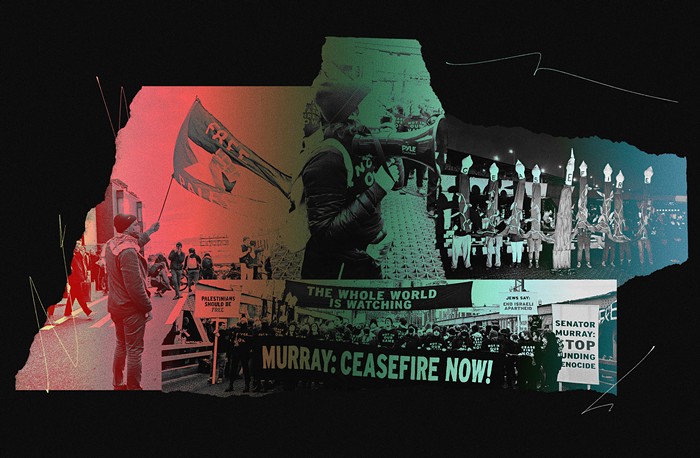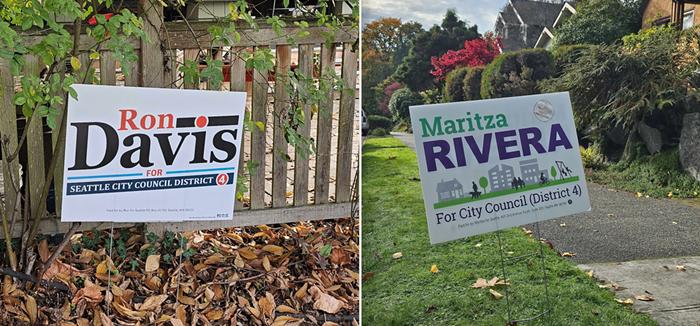
I know everyone is mourning the passing of David Bowie today, but there's a small cause for celebration, too. As Capitol Hill Seattle first reported yesterday, the blue bollards, colloquially known as smurf turds, are finally gone for good from the protected bike lane running along Broadway.
Countless times in recent years they were been pushed directly into the bike path, posing a hazard to cyclists. At long last, the city has replaced them with little white poles—the kind used on bike lanes around the city—that act as barriers as between parked cars on Broadway and nearby cyclists.
The fix is the culmination of at least eighteen months of citizen complaints to the Seattle Department of Transportation (SDOT) about the turds. They were first installed in 2014 as part of an abstract motif "related to sewing, needlework and beadwork" by local sculptor Claudia Fitch.
To review the grassroots campaign against the turds, briefly:
July 2014: I tweet at SDOT about a big turd blocking the lane. They send a crew out in a truck to fix it.
Fall 2014: But the turds keep getting knocked into the lane. Programmer Lee Colleton tweets at the department each time he notices, with photo evidence. SDOT keeps sending out trucks to put them back in place and tells me they'll implement a permanent fix by the end of the year.
January 2015: The agency fails to follow through. Predictably, the problem recurs.
February 2015: A cyclist encounters a series of turds completely upended on their sides, not merely bumped into the lane. It's an ugly scene. At the end of the month, SDOT fabricates special metal fasteners to hold the turds down.
August 2015: The fasteners don't work. The turds keep getting bumped into the bike lane. Colleton notices a fastener wrapped around a nearby tree.
January 2016: Another local walks through the area and photographs yet more turds in the middle of the bikeway. I retweet his pics at SDOT engineer Dongho Chang, who promises to temporarily remove the damaged turds and replace them with flex-posts—those white plastic poles—by the following week.
Which brings us to the present day. Someone with some sense—perhaps SDOT Director Scott Kubly, who didn't have much love for the bollards—finally made the decision to make their removal permanent.
Even Fitch, the artist who created them, suggested to a city arts commissioner that the bollards be removed months ago, she said in an interview today. "This was an experiment that just didn't work, given the environment," she said.
The design of the bollards went through many iterations and met strict engineering requirements, but they were unable to stand up to the roughness of Capitol Hill's urban core. Fitch said the cycletrack's landscape architects initially proposed using planters, not bollards, but the city rejected the idea over concerns about being able to perform the required upkeep.
And does calling the bollards smurf turds offend her? "No. I find it all really interesting," Fitch said, chuckling, calling it a "playful renaming." She'd heard others jokingly compare them to anal beads. "That's one of the conundrums of making public art, of being able to double see. To try look at it from the way anyone might be looking at it."
The idea, Fitch explained, was that the bollards themselves represented a thick looped wire—the same type of wire powering the long delayed streetcar which will connect the neighborhoods of Pioneer Square, the International District, First Hill, and Capitol Hill. "They're very abstract, I know," she said. "There are many things that it referenced that may not be obvious to viewer... This may have failed in that respect."
Perhaps there's a lesson here for SDOT. As I've said before, the agency's slowness to truly fix the recurring cycletrack hazard—a small and simple problem—doesn't much help locals who want to go out and make the case for more protected bike lanes. It also makes one wonder about the agency's competency and efficiency, not long after it won approval from voters for nearly $1 billion in new funding. Critics argued the Move Seattle levy amounted to a blank check for SDOT, and slow reactions like this can feed the conservative argument that SDOT is the last bunch of people you'd want to give a blank check—or any check—to.
At least the turds are gone now. Better late than never!


















